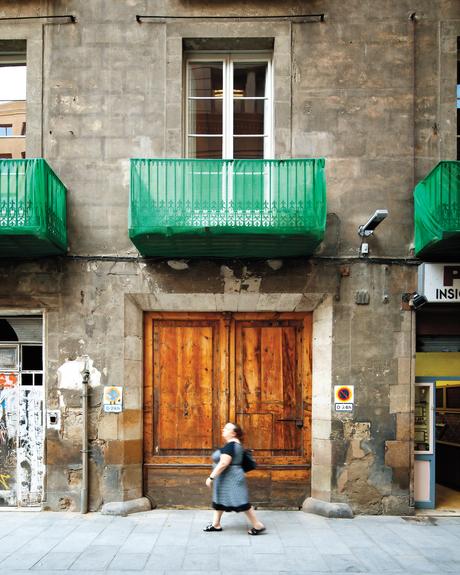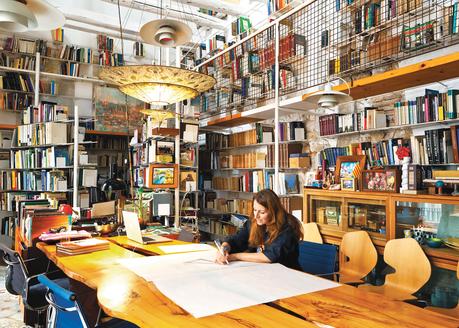
When architect Benedetta Tagliabue and her husband, the late architect Enric Miralles, began knocking down walls inside what was to become their home they discovered an original arch suspected to be a remnant of the city’s Roman past.
Project Tagliabue House Architect EMBT | Enric Miralles – Benedetta TagliabueIn the midst of Barcelona’s medieval core, a short walk from the city’s famous cathedral, sits a market like no other. Its graceful undulating roof, featuring a multicolored, pixelated pattern made of tiles, seems to float over the main volume, parts of which belong to the original 19th-century structure. Santa Caterina Market is the work of EMBT, a Barcelona-based studio founded by the architects Benedetta Tagliabue and her husband, the late, great Enric Miralles. The market, and the reorganization of its immediate surroundings, is not their most famous work—that title would go to the poetically unmonumental Scottish Parliament building, a project that was only partially completed when Miralles died in 2000. Nor is it their largest in the city, as an extra- ordinary double-volume HQ for Spain’s gas company is also here. But it’s certainly their most personal and accessible, and it’s an apt metaphor for both the couple’s creative and romantic union and their emotional engagement with this pocket of Barcelona.

Once through the street-level entrance, the property's modern garage door comes into view. Stairs lead up to the kitchen.
Tagliabue is a regular customer at the market. She lives with her two teenage children, a dog, and a parrot in an apartment on an adjacent street, in a home that has reached almost mythical status among the city’s doyens of architecture and design. (“Have you ever been to Bene’s house?” is a question often lobbed at their gatherings.) And with good reason: Here is a home so resplendent in memory, in detailing, in expressiveness, and in artistry that it leaves visitors intoxicated.When Milan-born Tagliabue first arrived in Barcelona in the early 1990s, the old town was a very different place. Pregentrification, it was dank and seedy, inhabited by generations of families who were perceived not to have the means to move to the brighter new burbs. Many of its medieval mansions were rundown and hidden by centuries of grime. Tagliabue was fascinated by this swath of neglected urban landscape, a story that started with the Romans and told in bricks and mortar. She took herself on architectural excursions, dis- covering Gothic vestiges covered by false facades, carved stone staircases behind unassuming doors, and frescoes languishing underneath layers of plaster. As was common in the not-so-distant past, her apartment had been used for decades as a warehouse, and ownership had remained in the same family for forever. “When we contacted the owner, who lived uptown, she said she had never set foot in it,” says Tagliabue, while sitting in the loosely colonial-inspired room that leads on to her home’s lush patio dominated by a huge quince tree. “We bought it for the same price as we would have a modest two-bedroom apartment in another part of the city.” She continues: “It was in a terrible state. The occupants had knocked down interior walls and the floor and ceiling were collapsing.” Making the residence structurally safe was the first and most technical intervention—the rest was left to evolve naturally, sometimes with the architects supervising, at other times leaving decisions to their small team of trusted tradesmen. No sketches or models were devised; nor was there a master plan of the type so popular for signature residences by many architects of their caliber. As Tagliabue has stated, the house itself, and its history, steered the direction of the works.

In her library, Tagliabue works at a table designed by Miralles.
The first thing that strikes you is the light. The rooms are situated in a circular layout around a central patio de luz that illuminates the living areas. The effect is heightened by the flooring made of diagonally placed rectangular patches of delightfully patterned baldosa hidráulica (tiles made with tinted cements, widely used in 19th-century homes here and in France) that reflect the sun’s rays, creating “rooms of light” as Tagliabue describes them. The second is the layering. The architects peeled away at the walls of the dwelling like an onion, revealing a Gothic capital featuring an angel and a frieze of vivid 18th-century decorative murals, along with the original sketches for them etched out on the wall of the adjacent room. “I called heritage assessors from city hall when we found them,” explains Tagliabue, “and they told us not to worry, as fragments such these are so common in this part of town.”These and countless other period elements have been left to breathe. They have not been restored, nor rendered a museum-like status with spotlights or framing, but rather left to revel in their deteriorated state and perform their vital roles within the harmony of the home. (Tagliabue lived for a period in Venice and it shows—the theme of decaying beauty is constant in her domestic landscape.) This organic, “leave well enough alone” approach extends to the decor.
Design classics such as an Eames lounge and an overhanging Fortuny lamp garner no more visual prominence than little clusters of travel memora- bilia or frameless family photographs propped up against old cigar boxes, textiles from Africa and Asia, and various pieces of furniture, prototype or otherwise, designed by Miralles—a split timber wooden dining table being the most magnificent example. That is not to say that each element and its placement hasn’t been considered; a melodious rhythm permeates in the way the architects have defined the function of each space, the use of diag- onally placed false walls that soften the rooms’ right angles, and an overall mise-en-scène that blurs cultures, historical periods, and the widely held modernist view of sophistication.

In the dining room, which opens to the backyard terrace, original tilework on the floors and walls complement decidedly modern counterparts—an original 1938 Butterfly chair by Antonio Bonet, Juan Kurchan, and Jorge Ferrari Hardoy, and a 1983 TMC floor lamp by Spanish designer Miguel Milá.
Miralles, a prolific book collector, spent hours arranging his collection of countless tomes on art and design, history and philosophy into “families” within a series of bookshelves suspended from the original beams of the double-height ceiling. On the day I meet her, Tagliabue casually picks up a photo album of the Scottish Parliament’s inauguration day, a building that was completed, with great controversy, four years after her husband’s untimely death. While she delights in this chance encounter I remark on the lack of view from the windows of the main living area (they look straight out onto the rear of an ugly modern office building). “Yes,” she agrees, “which is why my home is so introverted.”When Miralles died, Tagliabue decided to finish the projects they had started together. Their home was one of these, and she finally installed the lounge area with an indoor lap pool that leads off the patio, an idea that Miralles found excessive. She says it’s her favorite room in the house, and it’s easy to picture this vivacious and talented woman alone with her thoughts here. Well, perhaps not entirely alone. The spirit of her home and her husband’s presence are tangible, and the sense of chronological continuity between the walls—a force that they have interpreted with great sensitivity—feels infinite.
Click here to view more photos of the residence.
